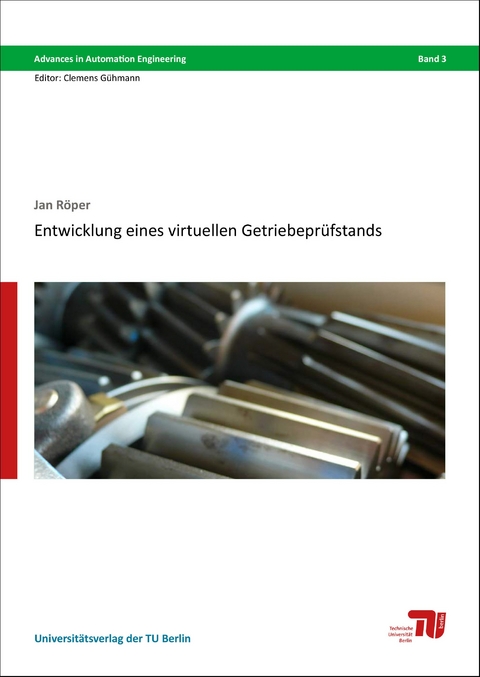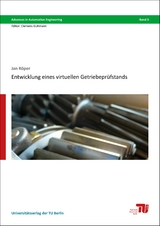Entwicklung eines virtuellen Getriebeprüfstands
Seiten
2017
Universitätsverlag der TU Berlin
978-3-7983-2951-5 (ISBN)
Universitätsverlag der TU Berlin
978-3-7983-2951-5 (ISBN)
- Keine Verlagsinformationen verfügbar
- Artikel merken
The demand for quality and safety tests at the production of automatic transmissions increases with their growing complexity. As a result, end-of-line tests are carried out automatically on test benches, which are used to stimulate and asses the characteristics of the test object. The development of test automation and test procedures is constrained by the availability of test object and test bench during the product development phase. A detailed evaluation of the test system performance can only be carried out close to the commissioning of the production line. The same applies to updates of the test system, which can only be tested during live operation of the production. To ease this bottleneck, a virtual test bench, which allows independent, thorough testing, is introduced. The virtual test bench consists of models of the test bench and the automatic transmission. The resulting setup can be compared to a hardware-in-the-loop system. The test automation software is the test object, which is executed on the original hardware, while test bench and automatic transmission are simulated separately. The virtual test bench also shows characteristics of a software-in-the-loop system, since it incorporates a simulation of the relevant transmission control unit software and the logic of the test bench programmable logic controller. The virtual test bench uses the same interfaces for the communication with the test automation as the real test bench. Therefore, a preliminary commissioning can be carried out to reduce the effort at the production site. A reconfiguration of the test automation after transfer to the production site is not necessary, which eliminates potential errors. The development of the virtual test bench is restricted by the availability of information during the product development process of the automatic transmission. However, information is typically available prior to hardware. The benefit of exploiting the available information is shown in this thesis. Models with different modeling depth are presented, which reflect the availability of information. With the resulting models typical tasks are carried out, which are representative for the development of an automatic test system for mechatronic systems. The tasks range from software tests and investigations on communication properties to the development of test methods for leakage in the transmissions hydraulic system. The ability and the limitations to assess the test system are shown for the different models. Potential model refinements and future applications of the virtual test bench are identified. Um die korrekte Montage und Funktion von Automatgetrieben sicherzustellen, werden diese am Ende der Produktion geprüft. Diese Prüfung wird durch eine Prüfautomatisierung ausgeführt, die mit Hilfe von Prüfprogrammen die Qualität der Getriebe bewertet. Bei der Entwicklung von Prüfautomatisierung und Prüfprogrammen stellt die Verfügbarkeit von Prüfstand und Prüfling eine Einschränkung dar. Insbesondere in frühen Phasen der Produktentstehung des Getriebes ist es nicht möglich das Verhalten des Prüfsystems zu testen. Um die Abhängigkeit von Prüfstand und Prüfling zu verringern, wird ein virtueller Getriebeprüfstand entwickelt, der aus Modellen von Prüfstand und Getriebe besteht. Die Logik der Prüfstandssteuerung (Speicher Programmierbare Steuerung) sowie Fragmente der Steuergerätesoftware des Getriebes werden ebenfalls abgebildet. Das entwickelte System kann mit einem Hardware in the Loop Prüfstand verglichen werden. Die Prüfautomatisierung und die Prüfprogramme werden auf der Zielhardware ausgeführt und sind das Testobjekt. Der virtuelle Getriebeprüfstand hat auch Gemeinsamkeiten mit Software in the Loop Systemen, da Teile der Steuergerätesoftware und der Prüfstandssteuerung simuliert werden. Für die Kommunikation zwischen Prüfautomatisierung und virtuellem Prüfstand werden die gleichen Schnittstellen wie in der Fertigung verwendet. Durch die Verwendung identischer Schnittstellen wird eine Vorabinbetriebnahme möglich, was zu verringertem Aufwand bei der Inbetriebnahme im Fertigungsbereich führt. Die erneute Konfiguration der Prüfautomatisierung in der realen Umgebung entfällt, wodurch potentielle Fehlerquellen ausgeschlossen werden. Die Entwicklung von Modellen von Prüfstand und Getriebe wird von der Verfügbarkeit von Informationen beeinflusst. Informationen sind jedoch deutlich früher verfügbar als Getriebe und Prüfstände. In dieser Arbeit werden Modelle mit unterschiedlicher Detaillierung entwickelt, die die Verfügbarkeit von Informationen widerspiegeln. Mit den verschiedenen Modellen werden typische Aufgaben der Entwicklung von Prüfautomatisierung und Prüfprogrammen bearbeitet. Die Aufgaben umfassen zum Beispiel Software- und Schnittstellentests für die eine geringe Detaillierung ausreicht. Als Beispiel für eine Aufgabe, die ein detailliertes Modell erfordert, wird ein Prüfverfahren für hydraulische Leckage entwickelt. Durch die Bearbeitung der Beispielaufgaben wird die Fähigkeit des virtuellen Prüfstands aufgezeigt den realen Prüfstand trotz der bestehenden Informationsabhängigkeit zu ersetzen. Potentiale für die Verbesserung der verwendeten Modelle, sowie zukünftige Anwendungsfälle für einen virtuellen Prüfstand werden aufgezeigt.
| Erscheinungsdatum | 28.11.2017 |
|---|---|
| Reihe/Serie | Advances in Automation Engineering ; 3 |
| Verlagsort | Berlin |
| Sprache | deutsch |
| Maße | 170 x 240 mm |
| Gewicht | 415 g |
| Themenwelt | Mathematik / Informatik ► Informatik ► Theorie / Studium |
| Technik ► Elektrotechnik / Energietechnik | |
| Technik ► Maschinenbau | |
| Schlagworte | Automatgetriebe • Automatic Transmission • Echtzeitsimulation • End-of-Line Prüfstand • end of line test bench • Hardware in the loop • Modeling • Modellbildung • real-time simulation |
| ISBN-10 | 3-7983-2951-6 / 3798329516 |
| ISBN-13 | 978-3-7983-2951-5 / 9783798329515 |
| Zustand | Neuware |
| Haben Sie eine Frage zum Produkt? |
Mehr entdecken
aus dem Bereich
aus dem Bereich
Grundlagen – Anwendungen – Perspektiven
Buch | Softcover (2022)
Springer Vieweg (Verlag)
CHF 48,95
Eine Einführung in die Systemtheorie
Buch | Softcover (2022)
UTB (Verlag)
CHF 34,95




